The 9.7" iPad Pro Review
by Brandon Chester on June 1, 2016 9:00 AM ESTDisplay Analysis
The 9.7" iPad Pro has what is by far the most interesting display I've seen on a tablet since the iPad 3, which was the first of the Retina displays. Samsung is arguably the only other vendor making advances with tablet displays, since they're the only company that ships a calibrated AMOLED. However, Samsung has been limited with the brightness they can push on the larger AMOLED displays, and at the end of the day when you set to sRGB the only advantage is the black level when there's not much ambient light to wash the display out.
With the iPad Pro Apple has improved upon the anti-reflective coating that they introduced with the iPad Air 2, and they've moved to a wider color gamut while also implementing a dynamic color feature called True Tone. I'll be talking about True Tone on the next page, but for now I'll be running 9.7" iPad Pro through our standard display workflow, along with an additional test to examine the accuracy within the DCI-P3 color gamut.
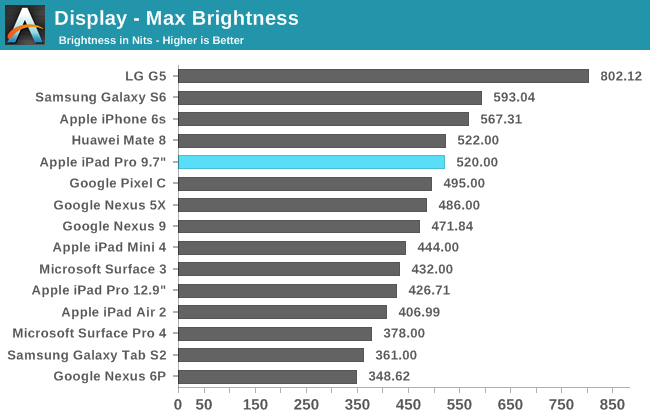
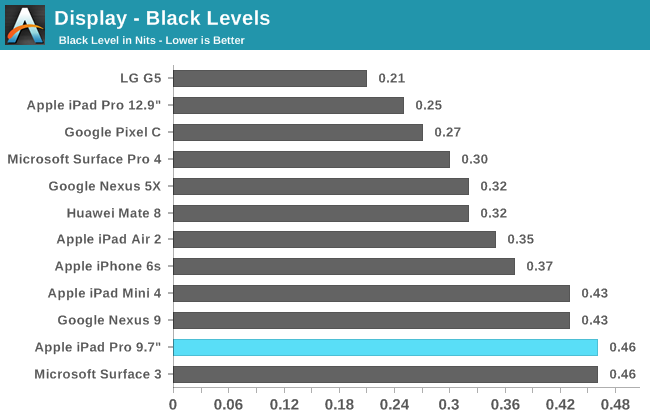
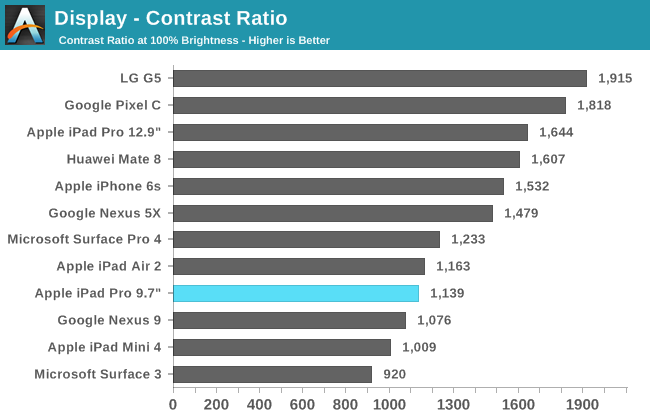
There are two things that I find surprising in the charts above. The first is that Apple actually exceeded their advertised 500 nit brightness. This puts it at the top of our brightness list for tablets, and that's no small feat. Apple's new backlighting array has enabled both a significantly wider gamut and a much higher brightness. Combined with their new anti-reflective coating, the 9.7" iPad Pro handily beats the larger model and the iPad Air 2 as the most usable tablet in bright ambient lighting.
While the 9.7" iPad Pro is quite bright, it doesn't do so well with black levels. Compared to the Pixel C, which has only a slightly lower brightness, the 9.7" iPad Pro's black level is much higher, and the contrast ratio is significantly lower as a result. It's also lower than Apple's 12.9" iPad Pro, and I verified Josh's brightness and black results for the 12.9" iPad against my own to confirm that he didn't just get an exceptional sample. I'm honestly a bit surprised that the gap between the two is so large, as the 9.7" iPad Pro's display is more advanced than the display of the larger model in several respects.
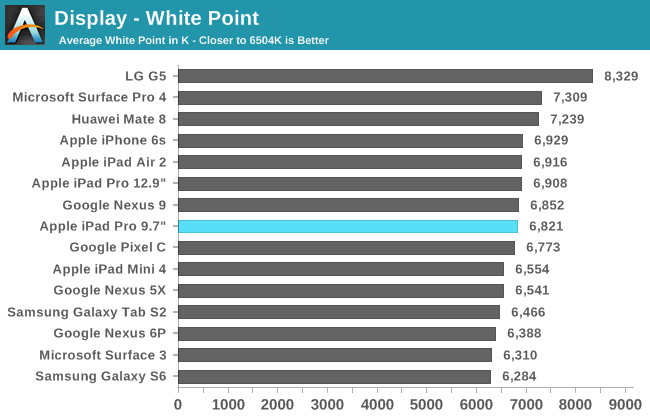

The 9.7" iPad Pro has great greyscale accuracy. Like most of Apple's products, there is a degree of blue shifting, but it's not quite as heavy as on their other products. The gamma is quite straight, and no shade of grey has a DeltaE that hits three, which is generally the goal. The accuracy isn't as high as the iPad Mini 4 which exhibited a surprisingly high degree of accuracy, but beyond the slight blue shift there's not really anything to complain about here.
DCI-P3 Gamut Saturation Sweep
The iPad Pro is Apple's second device that has moved to a wide color gamut. The first was the 2015 iMac with Retina 5K display, and from it we learned a number of things about Apple's implementation. The first thing to make note of is that the display conforms to the DCI-P3 gamut, but it doesn't use the corresponding 2.6 gamma that goes along with the standard. Using that gamma would be a mistake because no content coming on UltraHD Blu-ray is going to use that gamma function, so it's not really an issue in practice. While it remains to be seen how Apple's wide gamut devices will handle content that uses the SMPTE 2084 EOTF, Apple has brought color management to iOS and can transform content that uses a different gamma curve than the 2.2 gamma that the display targets.
Because Apple has implemented color management, they're able to accurately render anything designed for color spaces that sit within the DCI-P3 color space, with the most relevant one being sRGB. For devices with wide color gamuts and color management we'll be testing them against their target gamut and the sRGB gamut for our saturation tests. First up is the DCI-P3 saturation sweep, which uses 20% steps like our sRGB test but obviously targets the wider DCI-P3 gamut and uses Apple's target gamma of 2.2.
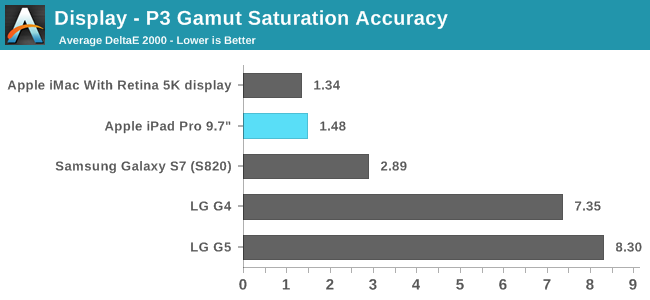
Because only a small group of devices claim to support this color gamut, I don't have as many points of comparison as we usually do. To be honest, the few that we have make it clear that Apple is currently without competition here. The other vendor actively advertising DCI-P3 gamut support is LG, and we've seen that the LG G4 and G5 do not even come close to actually meeting this goal regardless of which gamma target you use. In fact, they're bad enough that Samsung's accurate Adobe RGB mode on the Galaxy S7 accidentally beats them for P3 accuracy here, as it ends up being accurate in areas where the gamuts are very similar and only really has errors along red and with some deep saturations of colors that rely on red or blue.
As for Apple, they're the only vendor that actually covers the red-dependent segment of the gamut and their DeltaE values are incredibly low. The only issue I can see is that green is a bit inaccurate, which seems to be due to the display's blue shift. This is really me looking for criticism though, and with a DeltaE average of 1.48 the only device that beats it is a $2000 iMac.
sRGB Gamut Saturation Sweep
Because each 9.7" iPad Pro is individually calibrated, the color profile included is essentially a perfect description of the physical display's characteristics and color output. Because of this, the profile can be used to map colors from the sRGB color space to the display's native gamut with a high degree of precision, which is only limited by the display's color depth. In fact, this potentially allows for greater accuracy than if the display had been calibrated against the sRGB gamut in the first place, as the small error levels in Apple's calibration are accounted for by the profile and when doing color transformations.
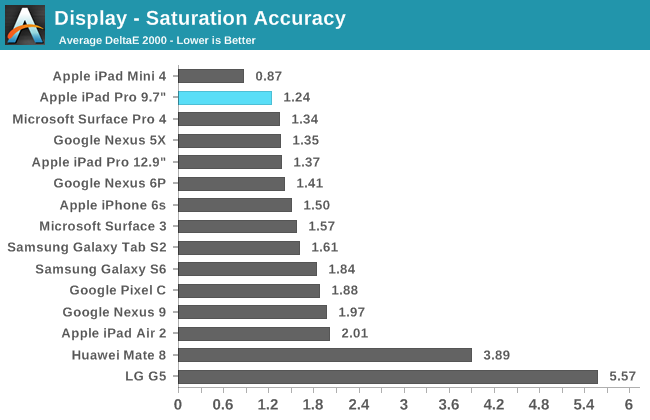
When displaying content designed for the sRGB gamut, the 9.7" iPad Pro is incredibly accurate. It's actually more accurate than the already near-perfect P3 results, with the red, blue, and green primaries being even closer to their target values. The only color that ever has an error above two is 20% saturated yellow, and the largest error is actually white which as we saw earlier is a bit too blue. Aside from those, every color has a DeltaE below two, and many are around or even below one. There's honestly not much more Apple could do here; this really is a professional-grade display.

As one would expect, the 9.7" iPad Pro has no trouble rendering the color mixtures from the GretagMacbeth ColorChecker test. The largest errors are actually the greyscale shades, and none of the DeltaE values for colors actually go above two. It's worth noting that the colors in this test are defined such that they should always be the same regardless of the color space, and so the fact that I've targeted sRGB has no change on the test outcome. For reference, changing the target to the P3 gamut produced an average DeltaE of 1.56, and I did that test at a later time so the error is well within the bounds of errors relating to the position of the meter on the display and the small inherent measurement error of the i1Pro 2 itself. This is a good example of Apple's color management at work, as my untagged image files were correctly inferred as having been created with the sRGB color space in mind, and transformed into the display's native gamut.
As far as tablet displays go, the 9.7" iPad Pro has the best one that I've seen. The combination of greatly improved peak brightness, extremely good color accuracy, an improved anti-reflective coating, and support for a wider color gamut all contribute to this, and the usefulness of aspects like the wide gamut will become even more apparent as time goes on and more content supporting it is released.



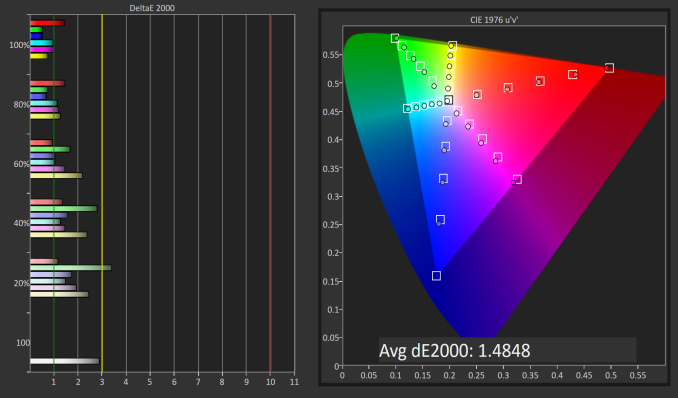
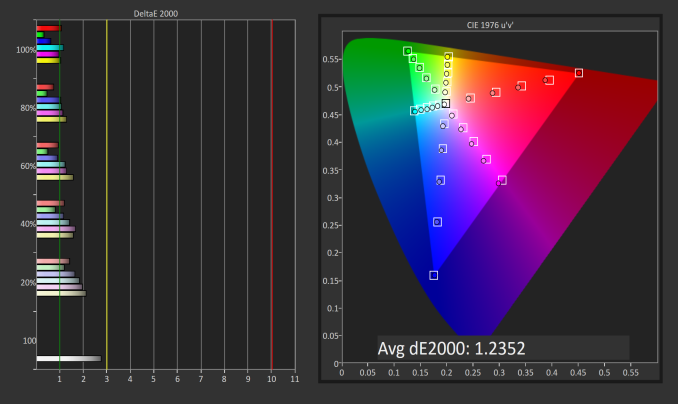
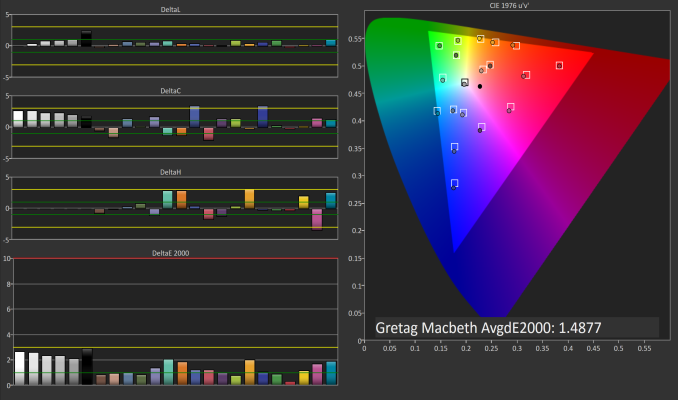








144 Comments
View All Comments
name99 - Wednesday, June 1, 2016 - link
"The 9.7" iPad Pro does well in 3DMark's graphics test, but like Ice Storm it doesn't do well in the physics test. It seems that this test is programmed in a similar way to Ice Storm, and in that sense I'm not sure how representative the physics test is of real-world performance "The physics test conveys utterly no information. If you look at the code, it's obvious that the physics score basically scales as frequency*numberOfCores. So those octacore CPUs get their one (and only...) chance to shine.
But all you're learning is something you already knew --- that the SoC has lotsa cores running at a high frequency. You're learning nothing predictive about how those cores behave on real code.
An analogy is to judging an SSD by its interface speed --- "ooh, it supports PCIe3x4 --- obviously it must run at 4GB/s under any and all circumstances", or to assuming that the only number you need to know about a memory system is that it connects to DDR4@2400.
name99 - Wednesday, June 1, 2016 - link
I find the NAND performance numbers very interesting when compared to that tiny new Samsung BGA SSD:http://www.anandtech.com/show/10385/samsung-begins...
Sure the Samsung numbers are perhaps 3x higher (given different testing methodologies, etc) but I suspect the Samsung volume and power are SUBSTANTIALLY higher. So Apple is doing remarkably well. It would be interesting to know if they are using tricks like TurboWrite (ie use part of the flash as pseudo-SLC) or if that's still on the table, available for next year's performance boost.
sfwineguy - Thursday, June 2, 2016 - link
Very useful review. Because my own habits may differ from other users, I'm still unsure as to whether I should spring for this new one of try to find an Air 2 (hopefully one with 64 gigs rather than the 16 Apple is offering direct). It seems a bunch of the benefit from the Pro is the camera, which is something I just don't care about.If they had given this the 4 gigs of RAM in the larger Pro, it would be a no brainer for me. I feel like Apple always holds back on the RAM (and tells us we don't need it), which obsoletes their devices quicker than I would like.
ragingfighter - Wednesday, July 13, 2016 - link
In general apple holds back so they get you to upgrade it's a business model it's the way it has to work or you'll be keeping your iPad forever. IN my opinion, I think even if you had a first generation Erewhon is aware the tablet to hold onto. You really have to ask yourself this is it worth spending $600 more not counting the pencil for an additional hundred or the keyboard for an additional 150 that's if you're talking about their base model if you're going be on that then you have to ask yourself if it's worth spending closer to seven to $800. What do you use your tablet for now? Do you find it slow? Have you went to the store and did a side-by-side such a Staples Best Buy or Apple? I would recommend doing that use them a little bit or even go as far as biting the bullet and buy an iPad Pro from Bestbuy demo them side-by-side on the weekend and decide then whether you going to keep it or return it. Depending on where you're from your givien A window of I believe 14 days to return at least a Best Buy it might be an option for you to try them of them both, but your conclusion and stick with itRobertJasiek - Thursday, June 2, 2016 - link
DisplayMate measures "lowest reflectance" but this is the best only for glare displays. Tablets with semi-matte, capacitative touch display must have a much lower reflectance but, unfortunately, so far come with 16:9 or 16:10 display ratios.I wish a Windows tablet with matte, semi-matte or current iPad-like low reflectance display; iPad-like display ratio, casing, weight, battery duration; battery replaceability or service; great WLAN range; BGA SSD; USB and thunderbolt 3. Still the manufacturers of Windows tablets fails to offer displays suitable outdoors with an acceptably low display ratio and a casing suitable for hours of hand holding.
Many iOS apps do not help if the needed functionality is not available; I find it only for Windows or maybe Linux. This and the missing general file management under iOS mean that 2/3 of my tasks incl. productivity (other than simple proofreading) is impossible on iPads. Therefore the iPad Pro 9.7 is too expensive. Its good hardware can never compensate the failure of iOS and apps. This may be different for some needing only mainstream apps and file formats.
adamod - Thursday, June 2, 2016 - link
i would buy it but its waaaay to thick for me...totally unacceptablearsjum - Thursday, June 2, 2016 - link
Is this sarcasm?samer1970 - Thursday, June 2, 2016 - link
the best tablet ? I dont think so , Core M3/5/7 Tablets are better and with full windows 10Hemlocke - Thursday, June 2, 2016 - link
Have you actually used them as tablets? The SP4 is a terrible tablet. It's heavier, it's stuck in landscape, it lacks a lot of touch-optimized apps, it has an inferior screen, and it has inferior battery life.Oh, but Windows, you say. That's great. To get a decent Windows experience laptop out of it, you're spending $1200 for everything, and a $999 Razer Blade Stealth smokes the half-assed laptop that is the SP4, leaving you with $200 to buy an Nvidia Shield Tablet K1, which is still a better tablet experience than the SP4.
nikon133 - Friday, June 3, 2016 - link
Have you used Surface as a tablet, though?I'm using SP3 as my main tablet and laptop. It is stuck in landscape only if you want to use kickstand. If you want to hold it in your hands, it works in portrait just fine. Since I love kickstand, only scenario I use it in portrait is for comics, which I read in app called Cover. Everything else I do in landscape, and even with heavier hardware, being able to use tablet with one hand (while it sits on my lap or on bed, table... at angle I like) while having the other hand free to hold a cup, glass, sandwich... is more than worth extra weight.
I have all the apps I need for tablet mode. Granted I'm not too demanding with apps, but usual stuff - browser, mail client, FB, maps, weather, FB messenger and Skype, YouTube player, News client, comics and ebook readers, music and media players... are all there and perform well under touch.
I can get 8 hours of light usage out of fully charged Surface Pro 3. Most common scenario, browsing, will fluctuate wildly, but hit usually comes with Flash-heavy sites. Not sure if I can open them on iPad at all. And then, there's very nice type cover sitting in vicinity - if at any moment I decide that whatever casual I do will require some serious typing, transformation is 1 second away.
As a laptop - surprisingly enough, SP4 released keyboard (which works with SP3, too) is one of finest laptop keyboards I have ever used, and even touchpad is quite good - maybe not on MB level, but as good as any Windows laptops does... and I still get to use touch screen, which I do. I wouldn't like touch screen on my desktop's screen, but on small screen that usually sits closer to me than desktop, it makes a lot of sense.
My SP3 also has full Office, Photoshop, Lightroom... among few other desktop programs. I'm using desktop for really heavy lifting at home - and gaming - and SP3 replaces laptop and tablet very nicely for me, at home and on travels. iPads are nice - I'm buying them for my mother every 2 years or so - but they just can't replace both laptop and tablet for me, and since I live in NZ - almost every trip is intercontinental, and having one device less to drag is easily noticeable.